January 10, 2025 · 10 min read
Using AI to Coordinate Multidisciplinary Care Team Meetings Efficiently

Shaimaa Badawi
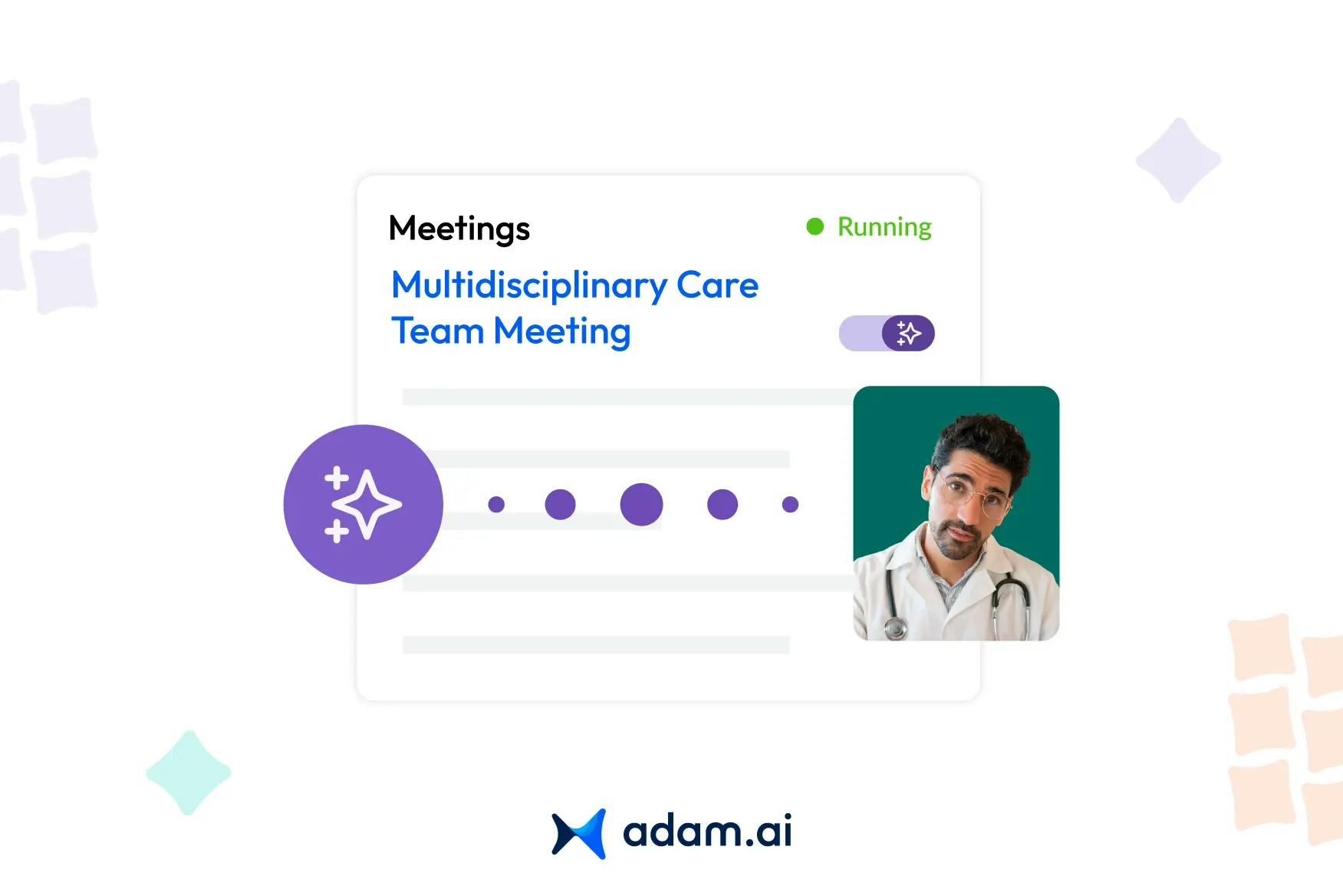
Coordinating multidisciplinary care team meetings is challenging, with issues like fragmented data, time constraints, and communication barriers affecting outcomes. In this article, we’ll unpack how AI and data-driven solutions are eliminating these barriers, helping teams focus on what truly matters: delivering exceptional patient care.
What is the role of multidisciplinary care team meetings in improving healthcare outcomes?
Multidisciplinary care team meetings (MDTMs) are a pivotal element in advancing patient care by integrating expertise from various medical disciplines. These meetings provide a structured environment for collaboration, allowing professionals such as physicians, nurses, social workers, and allied health specialists to collectively address complex patient needs.
Effective patient care coordination relies heavily on structured multidisciplinary meetings, where clear management practices ensure all team members contribute efficiently to the care plan. The result is more comprehensive, patient-centered care that considers every aspect of the individual’s health and circumstances.
How MDTMs improve healthcare outcomes
- Comprehensive treatment planning: By pooling knowledge and expertise, MDTMs ensure that patient care plans are thorough and tailored, addressing medical, psychological, and social factors that might otherwise be overlooked. Leadership plays a critical role in ensuring comprehensive treatment planning, as effective management aligns the team's goals and leverages individual expertise.
- Enhanced communication and coordination: These meetings provide a platform for team members to align on priorities, reducing the risk of miscommunication, fragmented care, or conflicting recommendations.
- Quality assurance and adherence to guidelines: Regular discussions foster adherence to clinical best practices, ensuring that treatment decisions are evidence-based and aligned with the latest standards.
Moreover, MDTMs have demonstrated measurable benefits in patient care. For example, cancer patients discussed in multidisciplinary meetings are more likely to receive timely diagnoses and appropriate treatments, leading to improved survival rates and better overall health outcomes.
How does AI enhance collaboration in multidisciplinary healthcare teams?
AI plays a transformative role in fostering collaboration among multidisciplinary healthcare teams, addressing key challenges like communication gaps, data overload, and time constraints. By providing intelligent tools and real-time support, AI enhances the ability of diverse professionals to work cohesively, ensuring optimal patient care. Here's how:
Centralized data integration
AI platforms consolidate data from various sources, such as electronic health records, diagnostic tools, and patient histories, into a single, accessible interface. This eliminates information silos, ensuring that all team members have access to up-to-date and accurate information during discussions.
Automated administrative tasks
AI-powered tools handle repetitive tasks like scheduling meetings, summarizing patient records, and generating action items. By automating these tasks, AI reduces meeting fatigue and allows team members to focus on meaningful discussions. This frees up time for team members to focus on critical decision-making and patient care.
Enhanced decision-making
AI supports clinical decisions by analyzing vast datasets, identifying trends, and providing evidence-based recommendations. For example, AI can suggest treatment plans based on similar past cases or predict patient outcomes using advanced analytics.
Real-time collaboration tools
AI-driven platforms enable seamless virtual communication through features like video conferencing with integrated data-sharing, enabling geographically dispersed teams to collaborate effectively without delay.
What are the common challenges in coordinating multidisciplinary care team meetings?
Coordinating multidisciplinary care team meetings is essential but often fraught with challenges that can hinder collaboration and efficiency. These obstacles stem from the complexity of bringing together diverse professionals, aligning schedules, and managing data effectively. Key challenges include the following:
- Scheduling conflicts: Aligning the availability of professionals across multiple disciplines is one of the most significant logistical hurdles, especially in busy healthcare environments.
- Information silos: Patient data is often dispersed across various systems and departments, making it difficult for team members to access comprehensive and up-to-date information during meetings.
- Communication barriers: Differences in terminologies, priorities, and workflows among specialties can lead to misunderstandings or delays in decision-making. The rise of telehealth and telemedicine has added complexity to communication, requiring teams to adapt to virtual collaboration while overcoming traditional barriers.
- Time constraints: Teams often face pressure to review multiple complex cases in a limited timeframe, potentially compromising the depth and quality of discussions.
- Technology limitations: Inefficient or outdated tools for virtual meetings and data sharing can disrupt workflows, particularly in geographically dispersed teams.
- Lack of accountability: Without clear roles or task ownership, follow-ups and action items from meetings may be delayed or overlooked, impacting patient care continuity.
What features should you look for in an AI platform for managing multidisciplinary care?
An effective AI platform for managing multidisciplinary care should provide tools that enhance collaboration, streamline workflows, and support informed decision-making. The following features are critical for ensuring that such platforms meet the complex needs of diverse healthcare teams:
- Centralized data management: The platform should integrate patient records, diagnostic data, treatment plans, and communication logs into a unified, easily accessible dashboard to eliminate information silos.
- Real-time collaboration tools: Features like live document sharing, AI-enabled video conferencing, and integrated chat functionalities ensure seamless communication, even for geographically dispersed teams.
- Automated scheduling and agenda management: Intelligent scheduling tools that align team members' calendars and auto-generate meeting agendas based on patient priorities save time and improve efficiency.
- AI-driven decision support: The platform should provide evidence-based recommendations by analyzing patient data, past outcomes, and clinical guidelines. Machine learning enhances meeting preparation by analyzing historical data to predict discussion points and streamline agenda creation.
- Action tracking and follow-ups: Built-in tools to assign, track, and remind team members of their tasks and deadlines ensure accountability and continuity of care.
- Data visualization: Intuitive dashboards that present complex patient data in easy-to-understand visual formats, such as charts and graphs, enhance clarity and support better decision-making during meetings.
- Compliance and security: The platform must adhere to healthcare regulations like HIPAA or GDPR, ensuring patient data security and privacy while facilitating seamless documentation and auditing.
- Scalability and customization: The ability to scale with organizational needs and customize workflows for different specialties or care teams ensures that the platform remains versatile and adaptable.
How do AI and real-time data integration enhance multidisciplinary meetings?
AI and real-time data integration significantly improve the efficiency and effectiveness of multidisciplinary meetings by addressing key challenges like fragmented data, time constraints, and communication gaps. These technologies empower healthcare teams to collaborate more effectively and make faster, better-informed decisions.
Here’s how AI and real-time data integration enhance these meetings:
- Centralized access to data: AI integrates information from multiple sources, such as electronic health records, lab results, and imaging systems, into a unified dashboard. This eliminates the need to navigate through fragmented systems, ensuring all team members have access to the same, up-to-date data.
- Streamlined decision-making: AI tools provide evidence-based recommendations, predictive analytics, and treatment options based on historical and real-time data. Streamlining decision-making not only enhances efficiency but also demonstrates a measurable ROI by significantly reducing meeting time. This helps teams focus on actionable insights and reduces the time spent on data analysis.
- Task automation: Administrative burdens like preparing agendas, summarizing meeting notes, and assigning tasks are automated by AI, allowing healthcare professionals to dedicate more time to patient-centered discussions.
How does AI ensure compliance and ethical decision-making in multidisciplinary healthcare?
AI enhances compliance and ethical decision-making in multidisciplinary healthcare by providing tools and processes that prioritize patient safety, fairness, and transparency. Here's how AI-driven platforms help teams make informed, responsible decisions while adhering to regulatory requirements:
- Adherence to clinical guidelines: AI systems are programmed to incorporate evidence-based guidelines and protocols, ensuring that recommendations align with current best practices. This reduces variability in decision-making and promotes standardized, high-quality care.
- Transparency and explainability: Modern AI tools offer clear insights into how recommendations or predictions are made. NLP tools can also analyze stakeholder sentiment, providing insights that ensure communication remains transparent and aligned with ethical standards. This explainability builds trust among healthcare providers and supports ethical decision-making by making the logic behind AI-driven outputs accessible and understandable.
- Real-time monitoring and auditing: AI platforms track decision-making processes and maintain detailed logs of actions taken during meetings. These records ensure accountability, simplify compliance with legal requirements, and provide an audit trail for regulatory review.
- Bias detection and mitigation: AI systems can identify and address biases in data or decision-making processes by analyzing large datasets for patterns that may disproportionately impact certain patient groups. This helps promote fairness and equitable care delivery.
- Privacy and security compliance: AI platforms are designed to comply with data protection regulations like HIPAA and GDPR. They employ advanced encryption and access controls to safeguard patient information, ensuring ethical handling of sensitive data.
- Ethical decision support: By analyzing ethical dilemmas and providing balanced options, AI tools can guide teams in addressing complex situations, such as end-of-life care or resource allocation, while considering patient rights and ethical principles.
- Continuous updates: AI systems can be updated in real time to reflect changes in regulations, guidelines, or ethical standards, ensuring that care delivery remains compliant with the latest requirements.
How can healthcare organizations implement AI to optimize team performance and patient outcomes?
Healthcare organizations can leverage AI to enhance team performance and patient outcomes by adopting a strategic, phased approach that integrates technology with existing workflows. Effective implementation ensures that AI becomes a valuable ally in improving efficiency, collaboration, and decision-making. Here's what you can do:
1. Assess organizational needs and readiness
Conduct a thorough assessment of existing processes, challenges, and areas where AI can make a measurable impact, such as reducing administrative burdens, improving diagnosis accuracy, or streamlining workflows.
2. Select the right AI platform
Choose a solution that aligns with organizational goals, offers seamless integration with current systems like electronic health records (EHRs), and provides essential features such as decision support, data visualization, and task automation.
3. Engage multidisciplinary stakeholders
Involve clinicians, IT staff, administrators, and patients early in the process to understand their needs, address concerns, and foster acceptance. Collaboration ensures the platform meets the requirements of diverse users.
4. Invest in training and education
Provide comprehensive training to team members on using AI tools effectively. Focus on enhancing digital literacy and addressing misconceptions about AI replacing human roles, emphasizing its supportive nature.
5. Implement in stages
Begin with pilot programs targeting specific use cases or departments to evaluate the platform’s effectiveness and gather feedback. Gradually expand adoption across the organization, refining processes as needed.
6. Monitor and evaluate outcomes
Use performance metrics like patient satisfaction, treatment timelines, and team productivity to assess AI’s impact. Continuously collect data to refine workflows and improve the platform’s effectiveness.
7. Ensure compliance and ethical use
Prioritize patient privacy and data security by implementing robust safeguards and ensuring compliance with regulations like HIPAA or GDPR. Address ethical considerations such as algorithmic bias and transparency in decision-making.
8. Foster a culture of collaboration and innovation
Encourage teams to embrace AI as a tool for enhancing their roles, not replacing them. Promote open communication about challenges and successes to drive adoption and create a feedback loop for improvement.
How does adam.ai help healthcare organizations improve multidisciplinary meetings?
adam.ai offers a range of intelligent features that empower healthcare organizations to optimize multidisciplinary meetings, streamline workflows, and enhance patient care. Here’s how:
- Agenda management: Create structured, detailed agendas, assign discussion topics to specific team members, and set time allocations for each item.
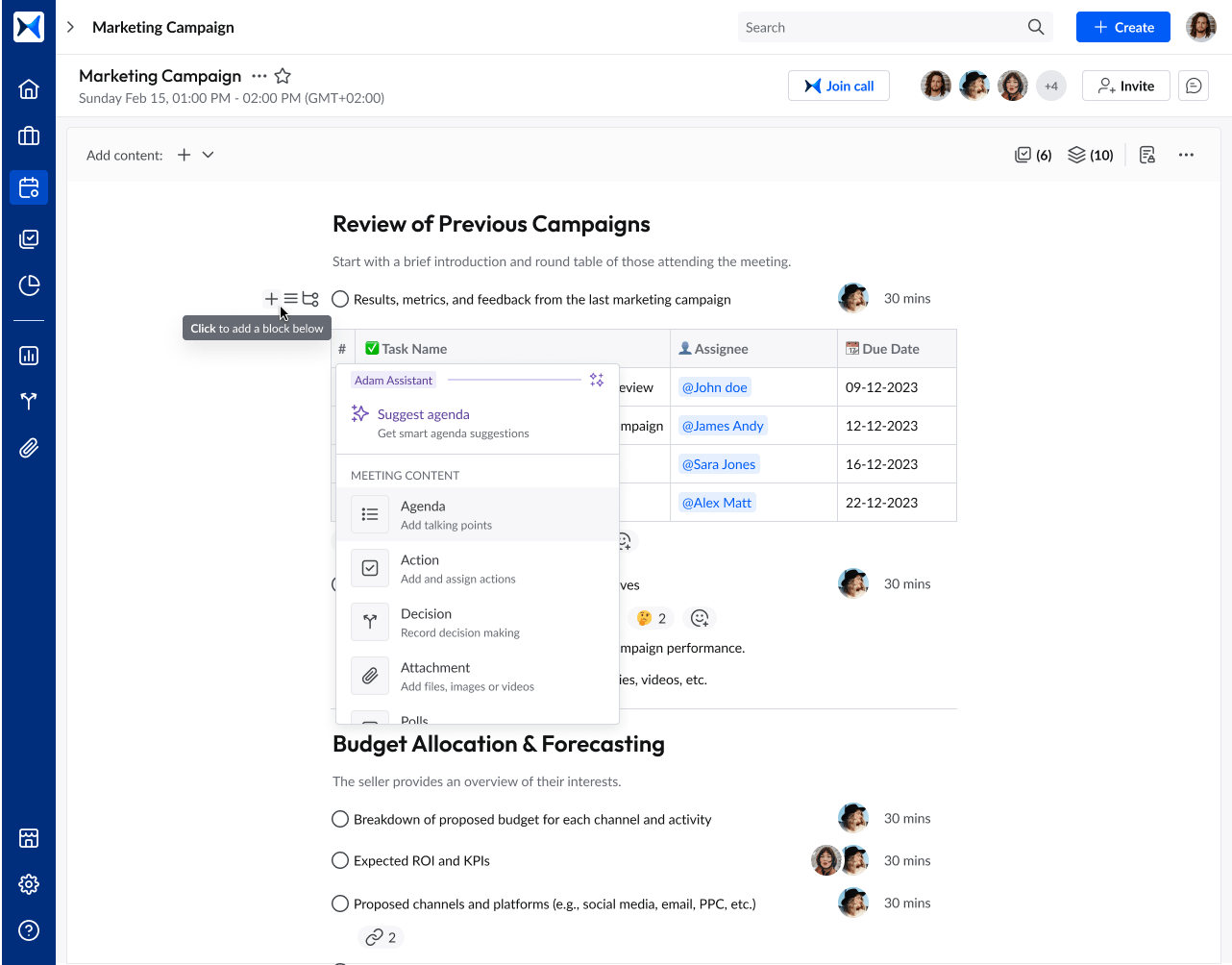
- Content collaboration: Share and collaborate on documents, reports, and diagnostic data in real time, where team members can comment, tag others, and attach relevant files.
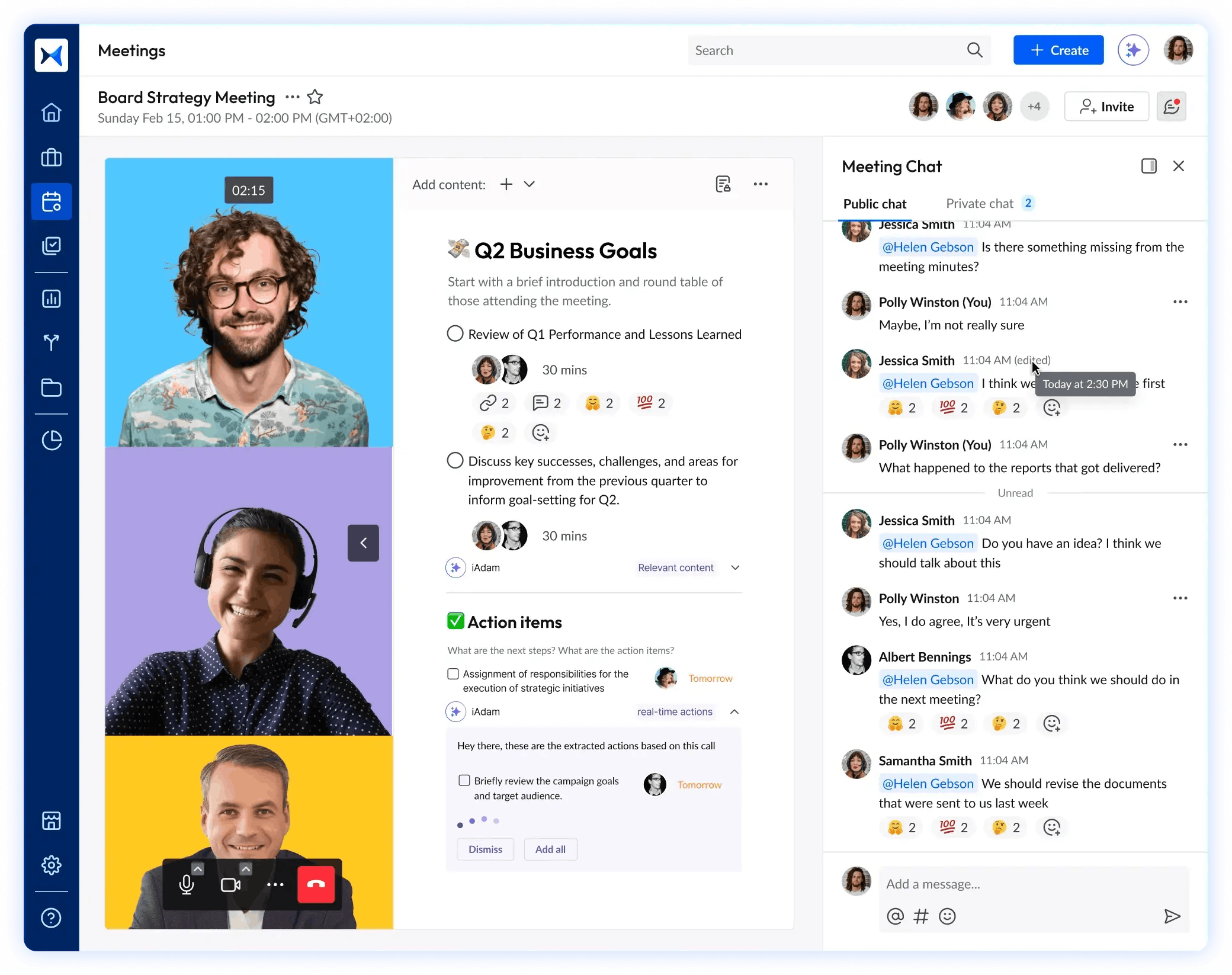
- Action tracking: Assign tasks to specific team members and monitor progress through actionable timelines to prevent follow-ups from slipping through the cracks.
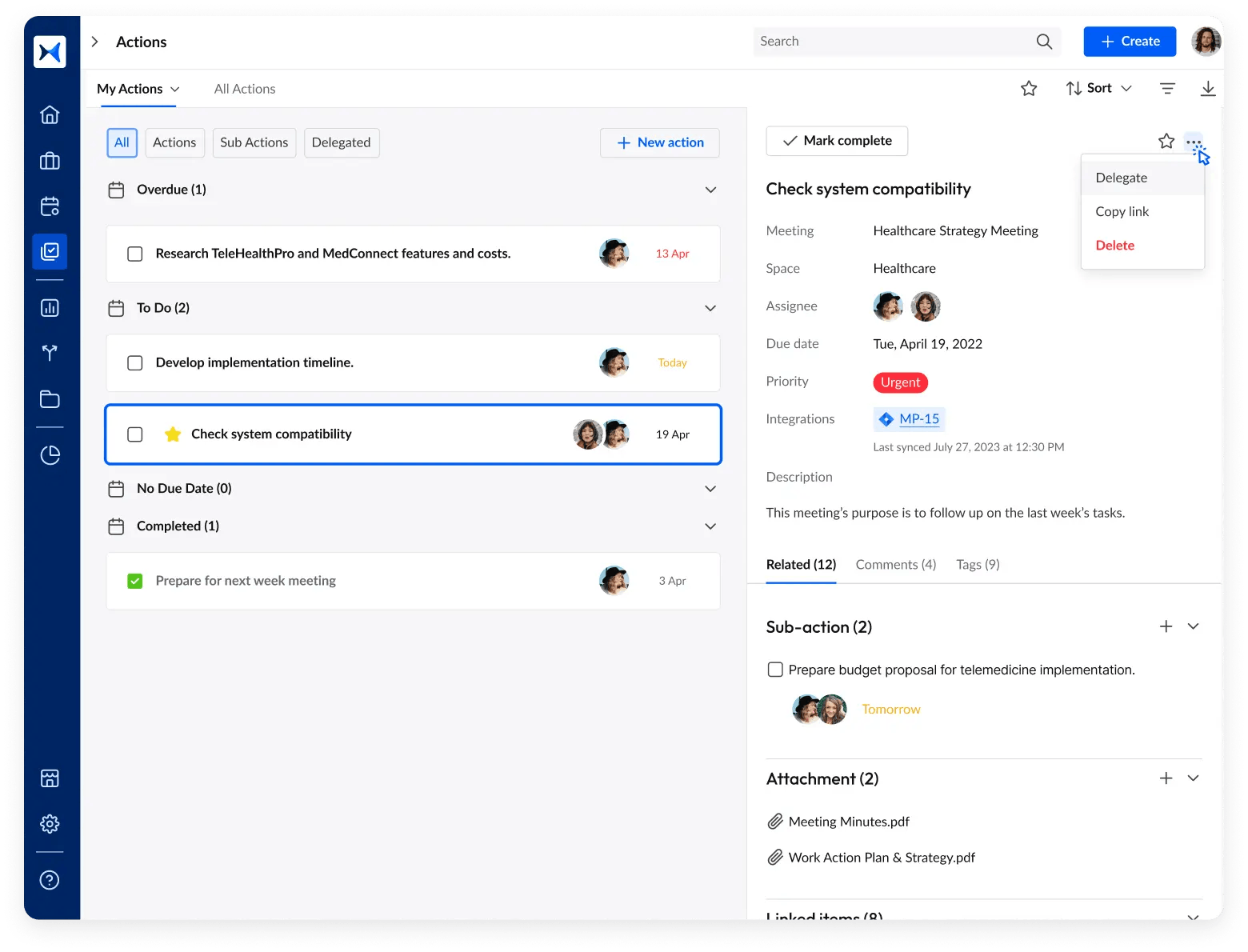
- Meeting minutes: Generate meeting minutes and capture key discussions, decisions, and action items to ensure all team members have a clear record of what was discussed and agreed upon.
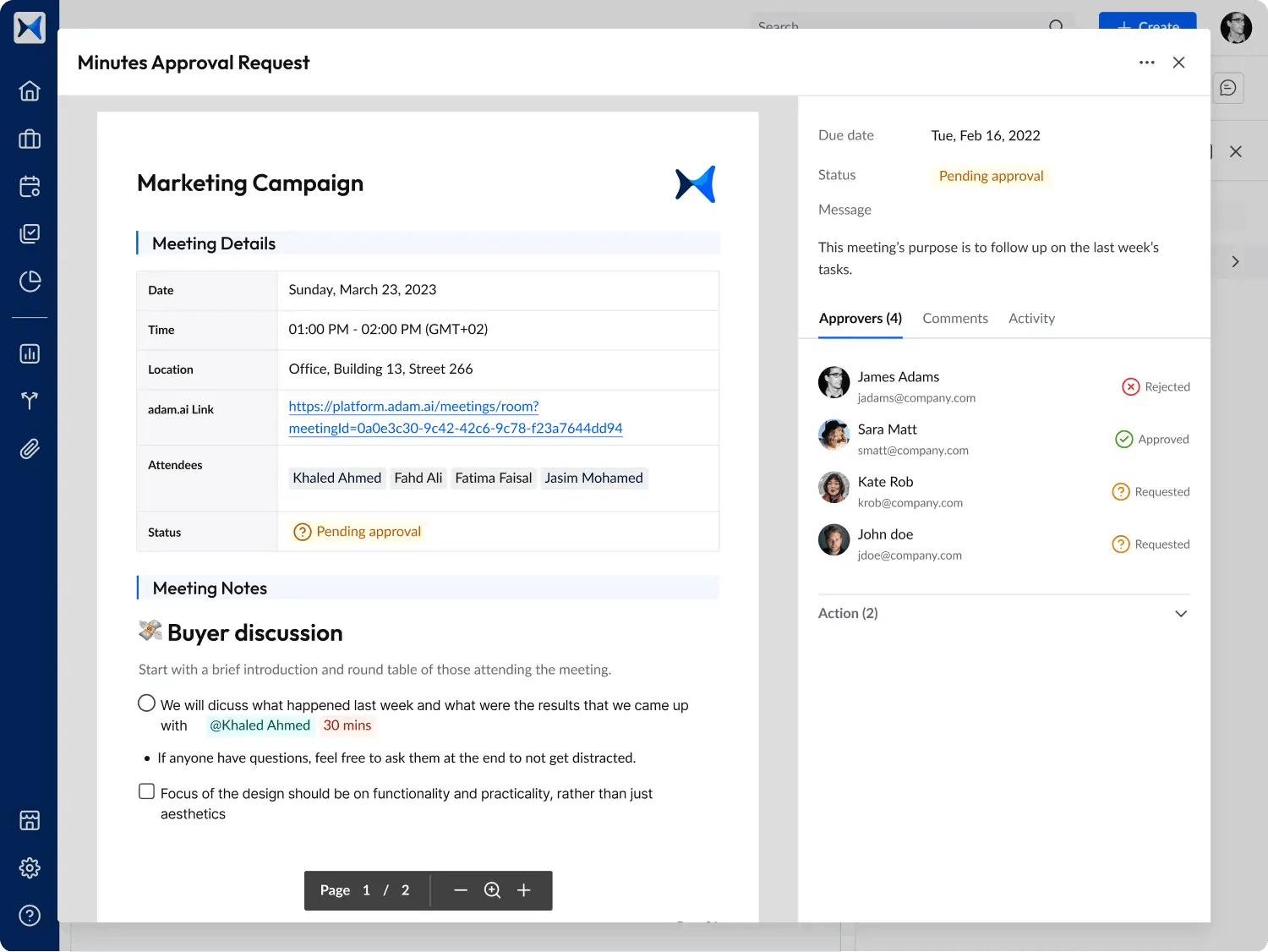
- Multi-space management: Organize meetings within dedicated spaces, keeping information categorized by departments, cases, or initiatives to simplify coordination across large teams.
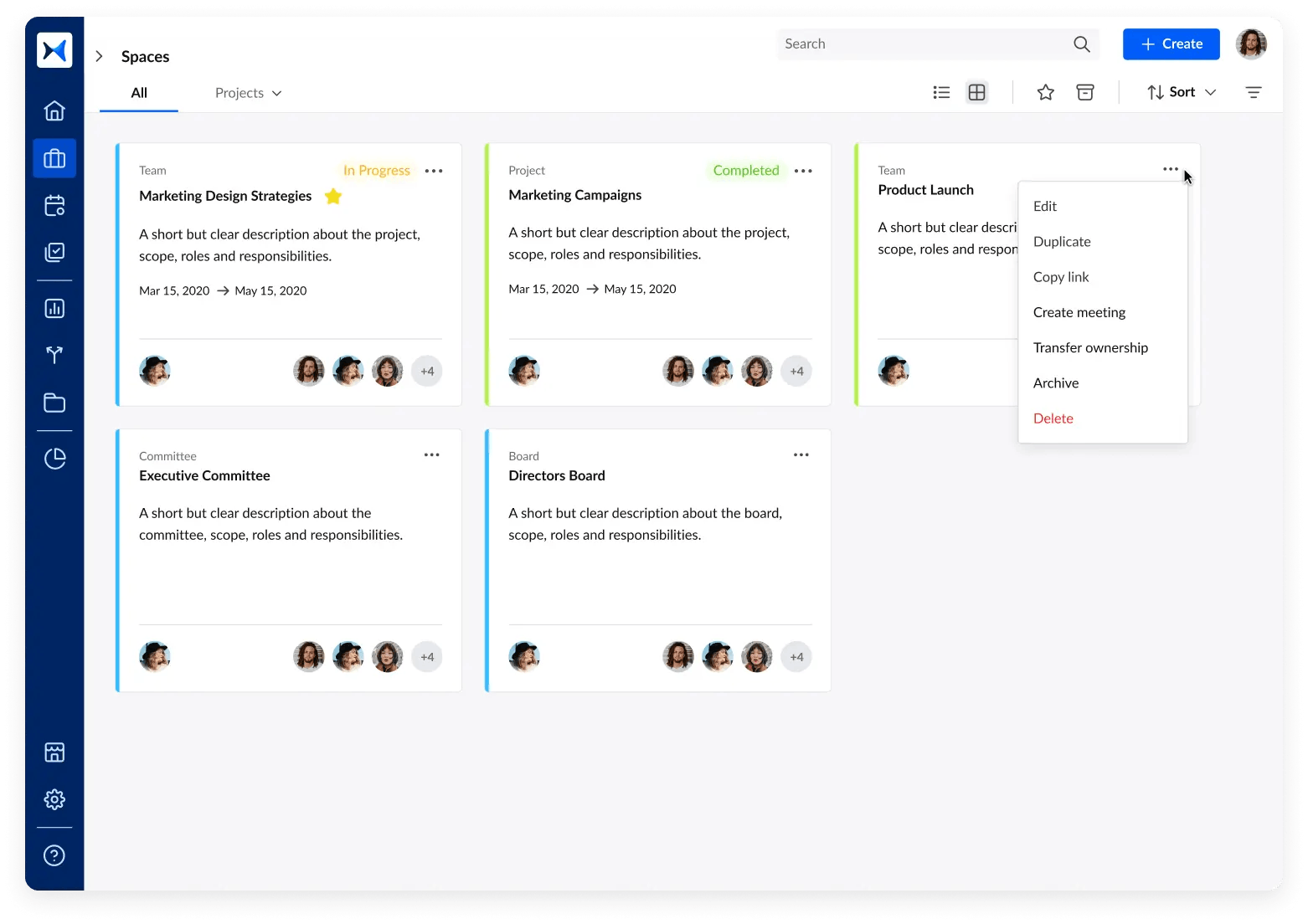
- Analytical dashboards: View insightful dashboards that track meeting effectiveness, attendance, and task completion rates to identify bottlenecks and improve overall meeting processes.
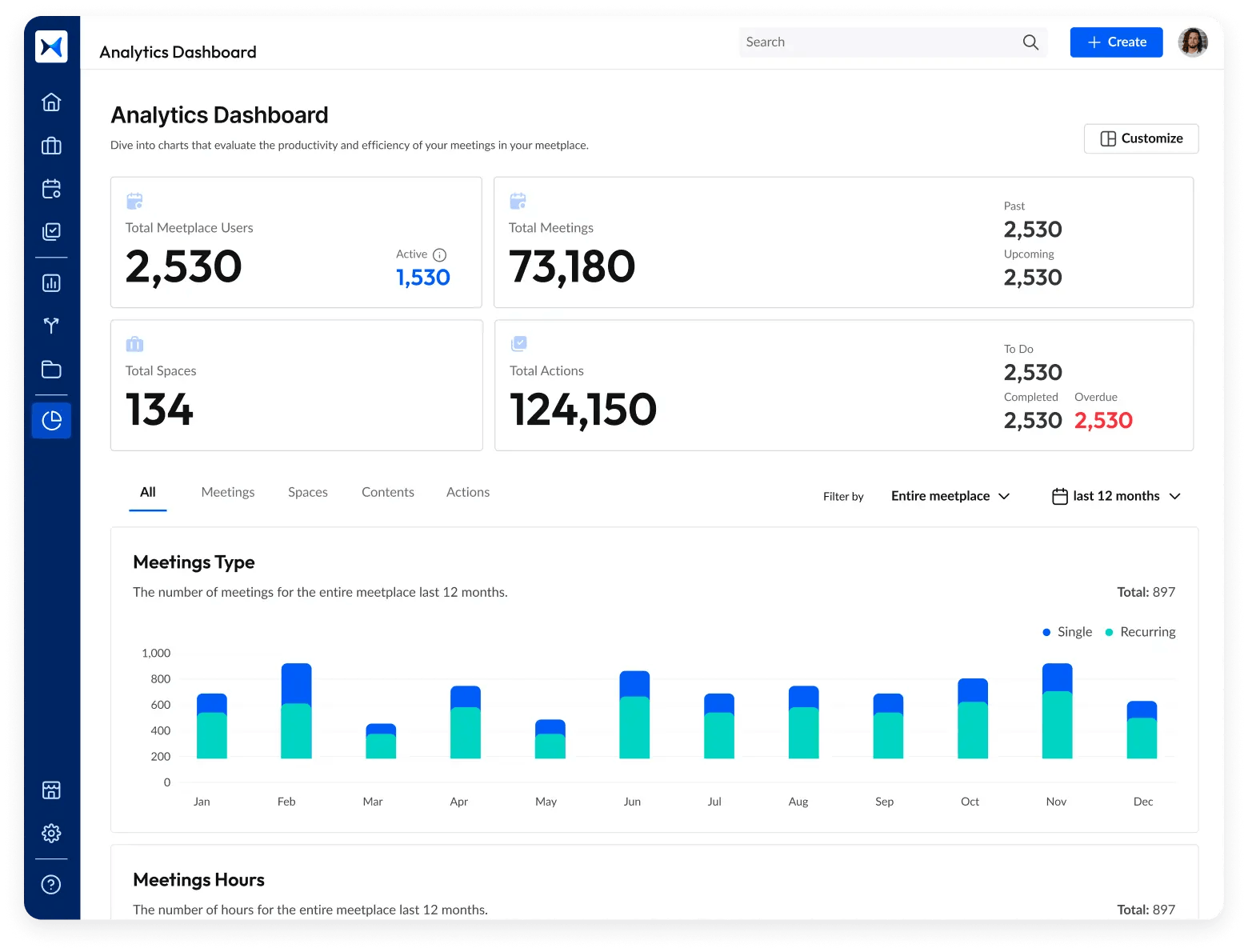
Transform how you conduct critical meetings—From meticulous preparation to effective execution and insightful follow-up, adam.ai integrates comprehensive analytics, full customization, and intuitive interfaces with powerful meeting management tools.
Easy onboarding. Enterprise-grade security. 24/7 dedicated support.
The bottom line
AI-powered tools are no longer just an option; they’re becoming essential for transforming multidisciplinary meetings into streamlined, outcome-driven discussions. With smarter workflows and real-time insights using AI-powered tools, healthcare teams are set to redefine patient care.
And while there may be multiple solutions available, here is why adam.ai is the meeting management software platform you can trust:
- adam.ai is one of Atlassian Ventures' portfolio companies.
- In the meeting management software category on G2, adam.ai has been ranked a leader and a high performer for successive quarters in the past years.
- adam.ai has been included in the Forrester Report in the AI-enabled meeting technology landscape.
- adam.ai is trusted and used by powerful teams and organizations worldwide for all types of critical meetings, like board, committee, project management, and business development meetings.
- And most importantly, adam.ai integrates with your existing workflow, is SOC2 compliant, provides dedicated support and success, and has a free trial option.
Subscribe to adam.ai blog
Stay ahead with the latest insights—get our newest blog posts, tips, and updates sent straight to your inbox.